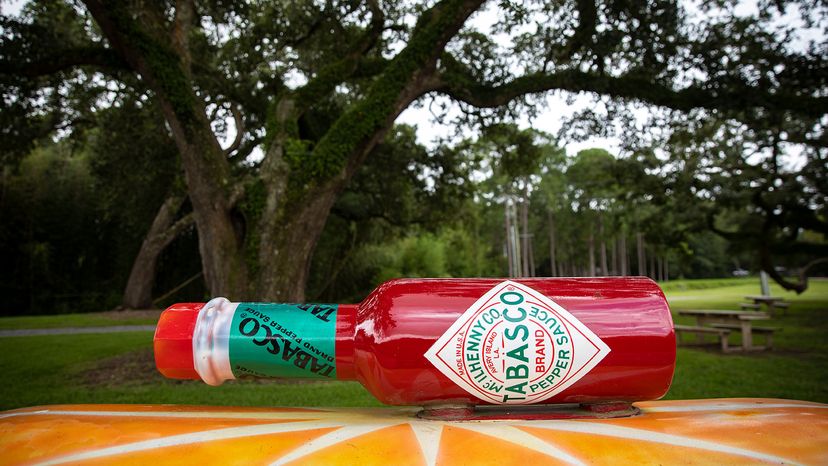 “An oversized bottle of Tabasco hot sauce is displayed outside of the Tabasco factory on the grounds of Avery Island, Louisiana, in 2019. The sauce has been made there for more than 150 years. Drew Angerer/Getty Images
“An oversized bottle of Tabasco hot sauce is displayed outside of the Tabasco factory on the grounds of Avery Island, Louisiana, in 2019. The sauce has been made there for more than 150 years. Drew Angerer/Getty Images
When it comes to American-made hot sauce brands, one name stands above the rest: Tabasco. The Tabasco company was founded in 1868 in the rural community of Avery Island in southern Louisiana. New Orleans banker Edmund McIlhenny, tired of the bland cuisine of the Reconstruction era, used pepper plants of the Tabasco variety (capsicum frutescens) brought from Latin America to create a spicy and delicious sauce.
McIlhenny called his creation Tabasco Pepper Sauce, patenting the name. The hot sauce quickly gained popularity in America and Europe in the 1870s thanks to the recipes the company created to use with the sauce. It is now an important part of Louisiana’s famous cuisine, added to dishes like shrimp etouffee. Relatives of the McIlhenny family still run the company.
The pepper sauce production process has remained relatively unchanged over the last 150 years. The field hands that originally worked on Avery Island used what’s known as le petit bâton rouge, or a "little red stick," to determine the Tabasco peppers’ ripeness. The pepper had to match the color of the deep red on the stick in order to be picked.
Surprisingly, despite technological advancement, the company still uses the sticks, as workers still pick peppers by hand. So far, a machine hasn’t been developed that can make that determination on ripeness, John Simmons, the great-great-great grandson of Edmund McIlhenny, told Louisiana Farm & Ranch. Versions of the red sticks are sold in Tabasco’s gift shop.
Once the right peppers have been selected, they are mashed and barrel-aged for up to three years in white oak barrels sourced from bourbon distilleries. Nowadays, most of the peppers are grown in Latin America and South Africa, but the pepper seeds all come from Avery Island. These are then shipped overseas for growing. After they are harvested, the peppers are ground, mixed with salt into a paste and shipped back to the island. Avery’s abundant salt reserves come in handy, as a thick layer of salt is placed on top of each sealed barrel. The salt settles into any small air holes that may exist in the barrel and prevents moisture from seeping in.
But don’t sample yet, as this pepper mash is a whopping 10 times hotter than Tabasco’s completed sauce. Each batch of mash is inspected by a member of the McIlhenny family to confirm that the color and aroma are just right. After the aging process, the mash is mixed with vinegar and churned for about three weeks. Then, the liquid is strained and poured into the classic red-topped glass bottles. Each of the 2-ounce (59-milliliter) bottles can hold 720 drops of the sauce and the Tabasco factory can produce up to 700,000 bottles per day.
The flagship variety of the sauce varies in heat, usually between 2,500 and 5,000 Scoville units, the measure of spice level. The brand boasts eight total varieties, including habanero, chipotle and sriracha, some of which may be hotter.
So, the next time you add Tabasco to your food, remember the process that goes into it, from one little red stick to a red-topped container.
Now That’s Spicy
Tabasco has also been a part of military rations around the globe and served to members of the British royal family and NASA astronauts. You can also visit Avery Island and take the factory tour, visit the gift shop and dine at the 1868 restaurant, where almost everything on the menu has some of the famous sauce in it.














































